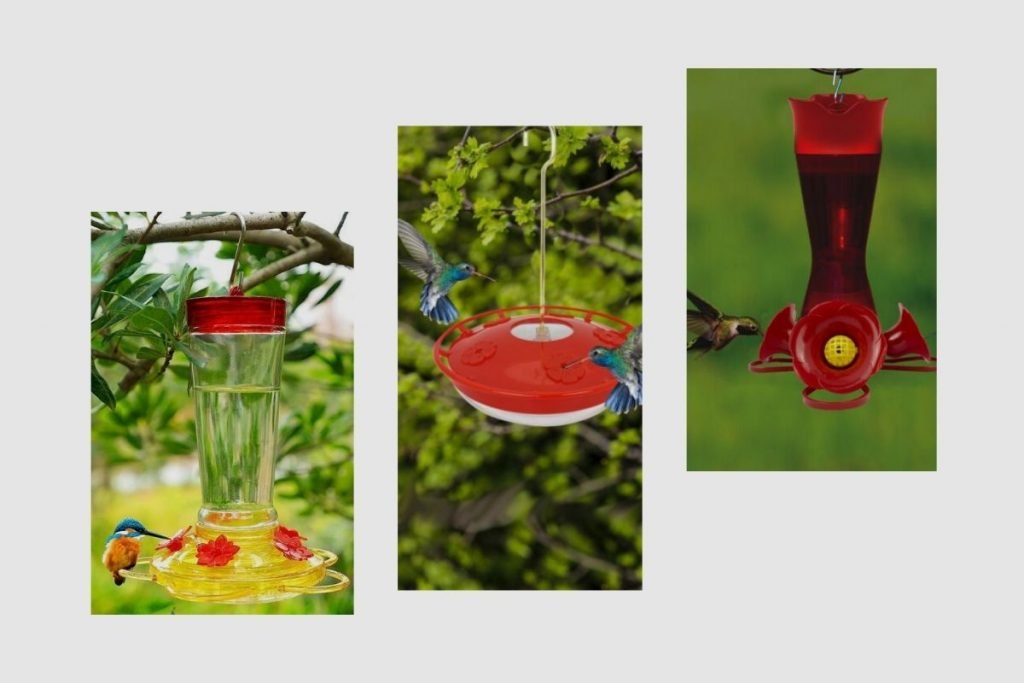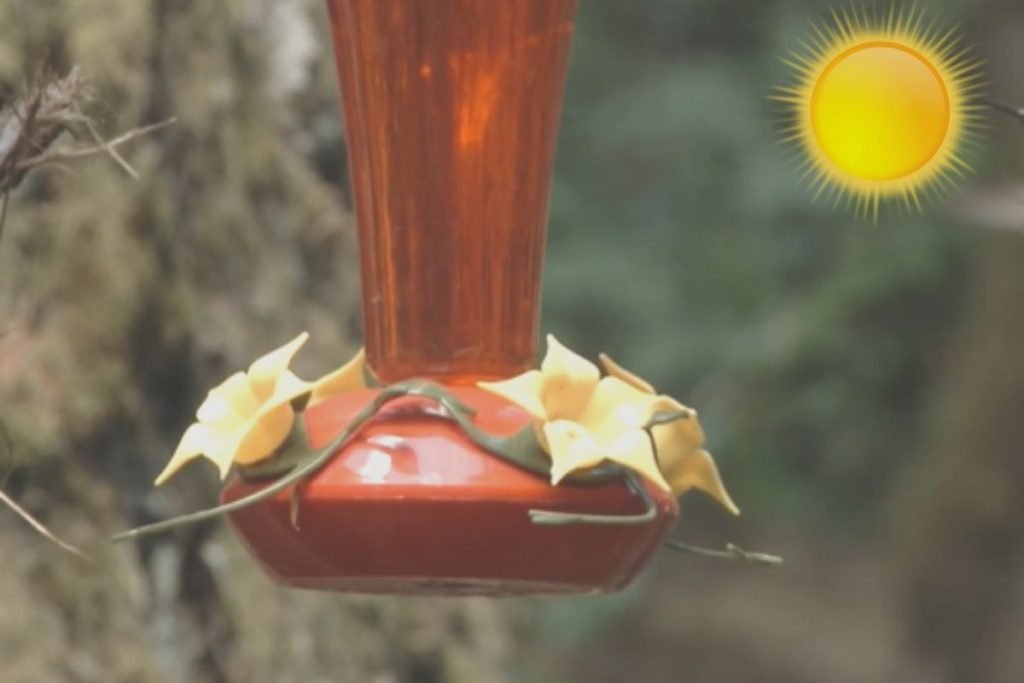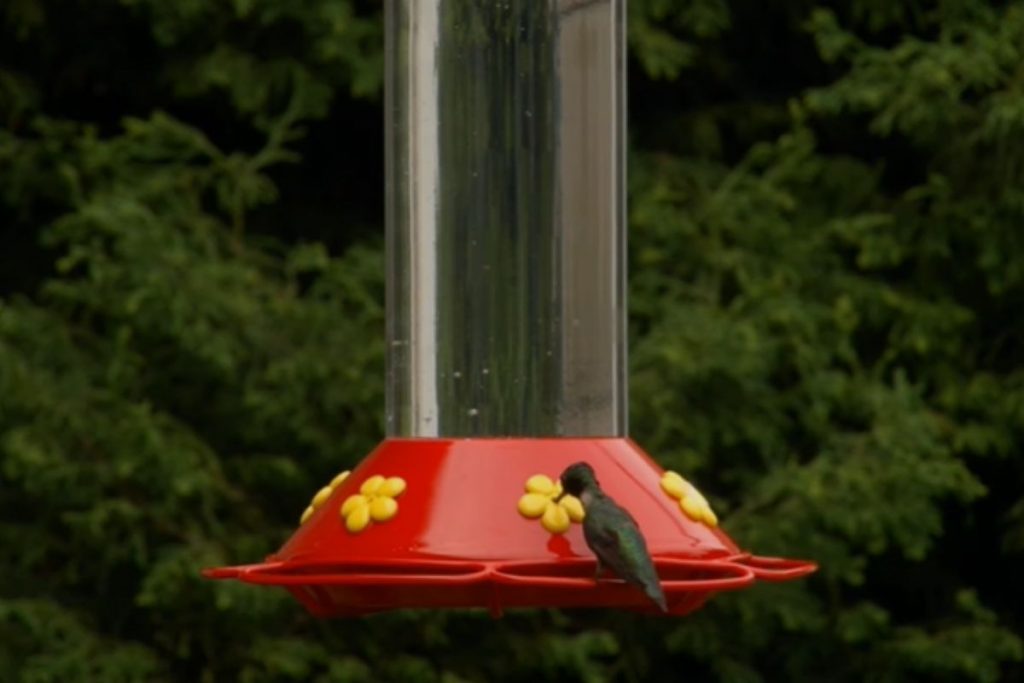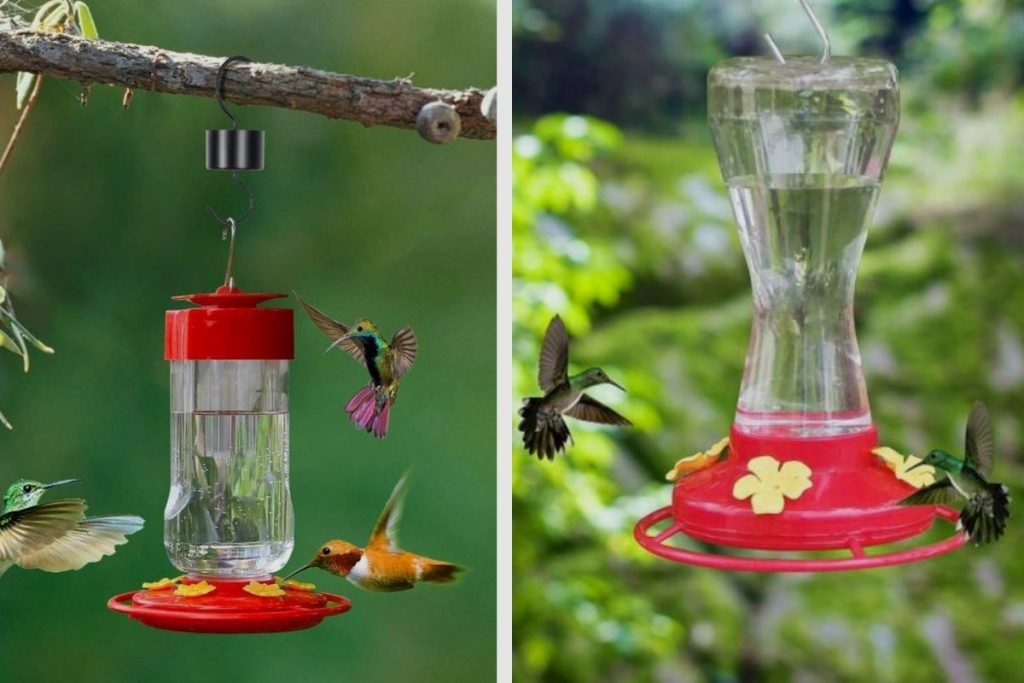A hummingbird feeder should be placed in a location with partial shade to provide optimal conditions for both the birds and the nectar. This placement ensures that the nectar does not spoil quickly due to direct sunlight while still offering a comfortable and visible spot for hummingbirds to feed.
Considering a hummingbird feeder in the sun has its benefits, as it may attract more birds due to better visibility. On the other hand, placing your hummingbird feeder in partial shade can help maintain the nectar’s freshness and provide a comfortable environment for the birds.
In this post, we will delve into the advantages and disadvantages of positioning a hummingbird feeder in sun and shade, ensuring you make an informed decision.
Related Posts To Read:
Best Hummingbird Feeders.
Hummingbird Feeders Comprehensive Guide.

What are the Pros of Placing a Hummingbird Feeder in the Sun?
While placing a hummingbird feeder in the sun has its advantages, it’s essential to consider the potential drawbacks and weigh them against the benefits. Here are the pros of placing a hummingbird feeder in the sun:
- Prevents freezing: The additional warmth from sunlight helps prevent the nectar from freezing, ensuring a consistent food source for hummingbirds in colder climates.
- Easier visibility: A feeder placed in the sun can be more easily spotted by hummingbirds, attracting them to your yard for feeding and observation.
- Discourages moss and fungus growth: Sunlight can inhibit the growth of moss and fungus, which could spoil the nectar and make it unsafe for the birds.
- Warmer resting areas: In cooler weather, a sunlit hummingbird feeder can create a warmer spot for the birds to rest and warm up after feeding.

What are the Cons of Placing a Hummingbird Feeder in the Sun?
The primary drawbacks of placing a hummingbird feeder in direct sunlight are related to the comfort and safety of the birds, as well as the longevity of the nectar. When a feeder is exposed to full sun, it can create an unfavourable environment for hummingbirds to feed. Below is a list of cons associated with placing a hummingbird feeder in the sun:
- Overheating: Direct sunlight can heat the nectar and make it too warm for the birds, potentially causing discomfort or deterring them from feeding.
- Nectar spoilage: Prolonged exposure to sunlight can cause the nectar to spoil more quickly, requiring more frequent cleaning and refilling.
- Limited bird activity: Some hummingbird species may avoid feeders in full sunlight due to the heat, reducing the number of birds visiting your feeder.
- Predator visibility: A feeder in direct sunlight is more easily spotted by predators such as hawks and cats, putting the hummingbirds at a higher risk of attack.
- Lack of resting spots: Hummingbirds often prefer shaded areas to rest between feeding sessions, and placing a feeder in the sun may not provide them with the necessary resting spots.
Bear in mind that when you place a hummingbird feeder in a partially shaded area, you can mitigate these cons discussed above and create a more favourable environment for the birds while extending the nectar’s lifespan.
What are the Pros of Placing a Hummingbird Feeder in the Shade?
Placing a hummingbird feeder in the shade offers several advantages for both the hummingbirds and the nectar inside the feeder. Providing a shaded spot for the feeder ensures that these small birds have a comfortable and safe environment to access their food. Here are the pros of placing a hummingbird feeder in the shade:
- Nectar longevity: Shade prevents direct sunlight from heating the nectar, which can cause it to spoil quickly. Cooler nectar lasts longer and remains fresh for hummingbirds to consume.
- Comfort for hummingbirds: Shaded areas offer a cooler environment, making it more comfortable for hummingbirds to feed, especially during hot summer days.
- Protection from predators: A shaded location, particularly near trees or bushes, provides cover for hummingbirds, reducing the risk of predation while they feed.
- Attracting more birds: Since shaded areas offer better protection and comfort, they can attract a larger number of hummingbirds to your feeder.
- Reduced evaporation: Nectar in shaded feeders will evaporate more slowly, maintaining a consistent supply for the hummingbirds to enjoy.

What are the Cons of Placing a Hummingbird Feeder in the Shade?
As much as placing a hummingbird feeder in the shade can have its benefits, there are also some drawbacks to consider before you make such a decision. The primary disadvantage of placing a feeder in the shade is that it may not provide sufficient warmth during cold weather. If positioned too far from direct sunlight, hummingbirds may struggle to access food when temperatures drop below freezing.
Other cons of placing a hummingbird feeder in the shade include the following:
- Reduced visibility: A shaded feeder may be less noticeable to hummingbirds, making it harder for them to find and access the nectar.
- Mold and bacteria growth: A feeder in the shade may encourage the growth of mold and bacteria, which can spoil the nectar more quickly and potentially harm the birds if consumed.
- Slower nectar consumption: Hummingbirds may be less likely to visit a shaded feeder due to the cooler temperatures, resulting in slower nectar consumption and a higher likelihood of spoilage.
Conclusion
In conclusion, finding the perfect location for your hummingbird feeder is essential to keep these delightful birds happy and healthy. To achieve the right balance, place the feeder in a partially shaded area that offers both warmth and protection from direct sunlight.
This way, you’ll minimize the risks associated with extreme temperatures, mold, and bacteria growth. Remember, the well-being of these beautiful creatures depends on providing them with a comfortable and safe environment. So, take the time to choose the ideal location for your hummingbird feeder and enjoy their enchanting presence in your outdoor space.
Frequently Asked Questions (FAQs)
Q: What is the ideal spot to place a hummingbird feeder?
A: The ideal spot for placing a hummingbird feeder is in a partially shaded area that offers both warmth from morning sunshine and protection from direct afternoon shade. This location ensures the nectar remains fresh and provides a comfortable environment for the hummingbirds.
Q: How does hot weather affect the nectar in hummingbird feeders?
A: Hot weather, especially extreme heat, can cause the nectar in hummingbird feeders to spoil quickly. This faster fermentation means the nectar may need to be replaced every couple of days to ensure it remains fresh.
Q: What are the benefits of placing a hummingbird feeder in a dappled shade near a flower bed?
A: Dappled shade near a flower bed provides a natural environment that attracts plenty of hummingbirds. The shade helps keep the nectar fresh, while the proximity to flowers offers an additional food source for the birds.
Q: Why should I consider placing my hummingbird feeder near a kitchen window?
A: Placing a hummingbird feeder near a kitchen window allows you to easily observe and enjoy these beautiful birds. The bright colours of the feeder can catch the attention of hummingbirds, making them more likely to visit.
Q: How does cold weather impact hummingbird food?
A: In cold weather, sugar water in the feeder might risk freezing (depending on the weather temperature). However, a sunny spot can provide additional warmth, preventing the nectar from freezing and ensuring a consistent food source for hummingbirds.
Q: What type of sugar solution is recommended for feeding hummingbirds?
A: A sugar solution made from granulated sugar and water, mimicking fresh nectar, is ideal for feeding hummingbirds. Ensure the sugar content is appropriate, as too much sugar can be harmful to them.
Q: Do glass feeders offer any advantage in warm weather?
A: Glass feeders can get hot under extreme heat, potentially causing the nectar to overheat. It’s essential to place glass feeders in a location with partial shade, like under a tree branch or a bushy tree, to keep the nectar fresh.
Q: How often should I replace the nectar in hummingbird feeders during hot weather?
A: During hot weather, replacing the nectar every couple of days is recommended to prevent harmful bacteria growth and maintain fresh hummingbird nectar.
Q: Is there a way to prevent ants from reaching my hummingbird feeder?
A: Yes, using an ant moat can deter ants from accessing the nectar in hummingbird feeders. It’s a barrier that prevents ants from reaching the sugar water.
Q: Can I provide homemade hummingbird food?
A: Absolutely. Homemade hummingbird food typically consists of a sugar solution made from granulated sugar and water, resembling fresh nectar-rich flowers’ content. Ensure the sugar content is accurate to offer a healthy food source.
Q: How do weather conditions affect the growth of mold in bird feeders?
A: Prolonged dampness without some sunlight, especially in shaded areas, can encourage the growth of mold in bird feeders. Regularly cleaning the feeder and placing it in an area with some morning sunshine can mitigate this issue.
Q: Why might larger birds avoid hummingbird feeders?
A: Hummingbird feeders are designed with small feeding ports tailored to hummingbirds’ size and feeding habits, making them less accessible or appealing to larger birds.
Q: Is there an advantage to placing a hummingbird feeder at eye level?
A: Placing a hummingbird feeder at eye level allows for easier observation of these enchanting birds, especially if it’s near a commonly viewed area like a kitchen window.
Q: Can I complement my hummingbird feeder with a bird bath or native flowers?
A: Yes, adding a bird bath or planting nectar-rich native flowers can make your yard more inviting, attracting a diverse range of hummingbird species, including the ruby-throated hummingbird, and providing a water source and additional feeding spots.
Q: How do dominant hummingbirds behave at active hummingbird feeders?
A: Dominant hummingbirds might be territorial and attempt to chase away other hummingbirds from active hummingbird feeders, especially if an abundance of fresh hummingbird nectar is available.
Image Gallery – Should Hummingbird Feeder Be In Sun Or Shade?




Useful Links:
Related Posts to Read:
- Do Hummingbirds Beaks Open When Feeding?
- The Mysteries of Hummingbird Flight.
- 6 Fascinating Facts About Hummingbird Sizes.
- Ruby-Throated Hummingbird Migration Map.
- Where Do Hummingbirds Go When It Rains?
- How Much Does A Hummingbird Eat Per Day?
- Do Hummingbirds Eat Bees?
- Do Hummingbirds Eat Wasps?
References:
- About Hummingbird (Link).
- Greenewalt, C. H. (1960). Hummingbirds. New York: Doubleday. Google Scholar.
- Carey C. The impacts of climate change on the annual cycles of birds. Philos Trans R Soc Lond B Biol Sci. 2009 Nov 27; 364(1534):3321-30. doi: 10.1098/rstb.2009.0182. PMID: 19833644; PMCID: PMC2781852.
- Rico-Guevara A, Rubega MA, Hurme KJ, Dudley R. Shifting Paradigms in the Mechanics of Nectar Extraction and Hummingbird Bill Morphology. Integr Org Biol. 2019 Jan 2;1(1):oby006. doi: 10.1093/iob/oby006. PMID: 33791513; PMCID: PMC7671138.
- Tyrrell LP, Goller B, Moore BA, Altshuler DL, Fernández-Juricic E. The Orientation of Visual Space from the Perspective of Hummingbirds. Front Neurosci. 2018 Jan 30;12:16. doi: 10.3389/fnins.2018.00016. PMID: 29440985; PMCID: PMC5797624.
- Hummingbirds Sighting (Journey North Map).
- About Hummingbird’s Characteristics.
- About Bird Feeder (Link).

We have our feeders in shade in the morning and partial sun in the afternoon. They have no trouble finding the feeders. It is like O’Hare airport from sunup till dusk. They are right outside the windows at our breakfast nook and there are bushes close by for them to rest and hide from predators. They empty the feeders almost daily so the nectar never spoils. Really enjoy 😊 the antics of these wonderful birds!
Hi Drue,
It sounds like you’ve created a perfect hummingbird haven for them! The combination of shade, partial sun, and nearby bushes appears to be just what they need. Thanks for sharing your lovely experience, and keep cherishing their charming presence!
Well Dah how about those people that still use Red Nectar the stuff with dye in it my goodness some common sense would be appreciated like why do they give people that can’t even take care of them selves companion animals? What kind of sense does that make?
Thank you for sharing your concerns. You’re absolutely right that using red nectar with dye can be harmful to hummingbirds. It’s always recommended to use natural solutions without added colouring. Unfortunately, some still do.
Also, regarding your point on companion animals, I believe it’s essential that anyone caring for an animal, whether it’s for companionship or otherwise, should ensure the well-being of that animal as a priority. Unfortunately, all these are not always the case.
Once again, thanks for sharing your concerns.
Is cold sugar water the best hummingbird food.?
Hi Geri,
Thanks for your question! While cold sugar water is acceptable for hummingbirds, it’s not necessarily the best. Room temperature or lukewarm sugar water is preferable as it’s more comfortable for them and helps in energy conservation. That said, natural flower nectar is still their primary source of food. The sugar water only serves as a supplemental source, especially during times when nectar might be scarce.
Please read this article for better clarity: “Can You Give Hummingbirds Cold Sugar Water?”
Hope this helps!
I have my bird feeders on my porch in the sun. They have 1 big thick bush and a thick tree right beside my porch that they can go to ( I call them my hummingbird trees). I also have a flower garden right below their feeders. I usually have about 30 hummingbirds at any given time. I have to make a gallon of nectar every 2 days. They have no problem here.
Hi Kim,
That sounds great! Thank you for taking the time to share your valuable experience. We truly appreciate it.
Happy birdwatching!